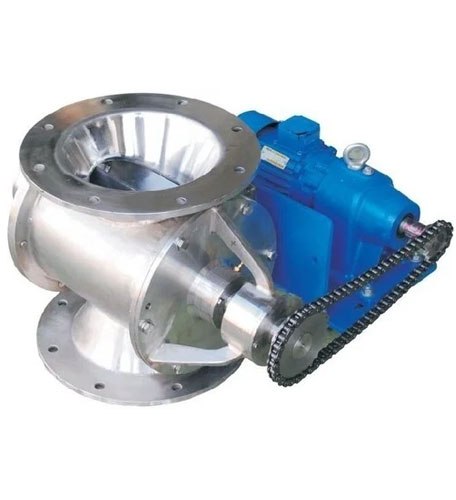Working Principle
The rotary airlock valve works by rotating the rotor with a
constant speed, which allows materials to enter the pockets formed between the
rotor blades. As the rotor turns, these pockets move from the inlet to the
outlet. The rotation prevents air from bypassing the material, ensuring that the
system operates in a sealed manner, maintaining pressure or vacuum conditions on
both sides of the valve.
- Feeding: Material enters the valve through the inlet while
the rotor is rotating.
- Sealing: The pockets in the rotor seal the material inside
as it rotates.
- Discharge: The material is then discharged through the
outlet port as the rotor continues to turn
Applications:
- Pneumatic Conveying Systems: Used to meter materials into
pneumatic systems for transport.
- Dust Collection Systems: To control the flow of air and
dust particles while preventing air leakage.
- Silo Discharge Systems: Rotary airlocks can be used to
unload material from silos or hoppers.
- Mixing & Blending: Used to feed materials in a controlled
manner to blending or mixing processes.
- Bagging Systems: Often used in systems that bag products to
ensure consistent and reliable filling.
Types of Rotary Airlock Valves:
- Standard Rotary Valves: For general-purpose applications
handling free-flowing bulk materials.
- Heavy Duty Rotary Valves: Designed for applications
involving heavy or abrasive materials like cement or fly ash.
- Corrosion-Resistant Rotary Valves: Constructed from
stainless steel or coated materials for use with corrosive materials.
- Food-Grade Rotary Valves: Manufactured to meet hygiene
standards for food processing and pharmaceutical industries.
Advantages:
- Precise Material Control: Ensures accurate and consistent
material flow rates.
- Pressure Control: Helps maintain pressure differentials in
pneumatic systems.
- Versatile: Can handle a wide range of materials, from
powders to pellets.
- Durability: Often designed for heavy-duty applications and
can withstand wear and tear from abrasive materials.
- Energy Efficiency: Helps maintain an efficient flow with
minimal energy loss.
Disadvantages:
Wear Over Time: The rotor and seals can wear out, especially when handling
abrasive materials, requiring periodic maintenance or replacement.
Additional Information:
- Item Code:IND150
- Pay Mode Terms: L/C (Letter of Credit),T/T (Bank
Transfer),D/P,D/A,Other
- Production Capacity:1 TONS
- Delivery Time: 45 DAY
- Packaging Details: 1 BOX
Technical Specification
| Title |
SPECIFICATIONS |
| Diameter |
250 mm |
| Capacity |
1 ton/hour |
| Location/City |
Navi Mumbai |
| Brand |
DK Systems |
| Model |
IND150 |
| Material |
SS316L - MS |
| Size |
ID200*H300-MM STD ANSI 150LBS |
| Condition |
New |
| Application |
Ceramic |
| Country of Origin |
Made in India |





